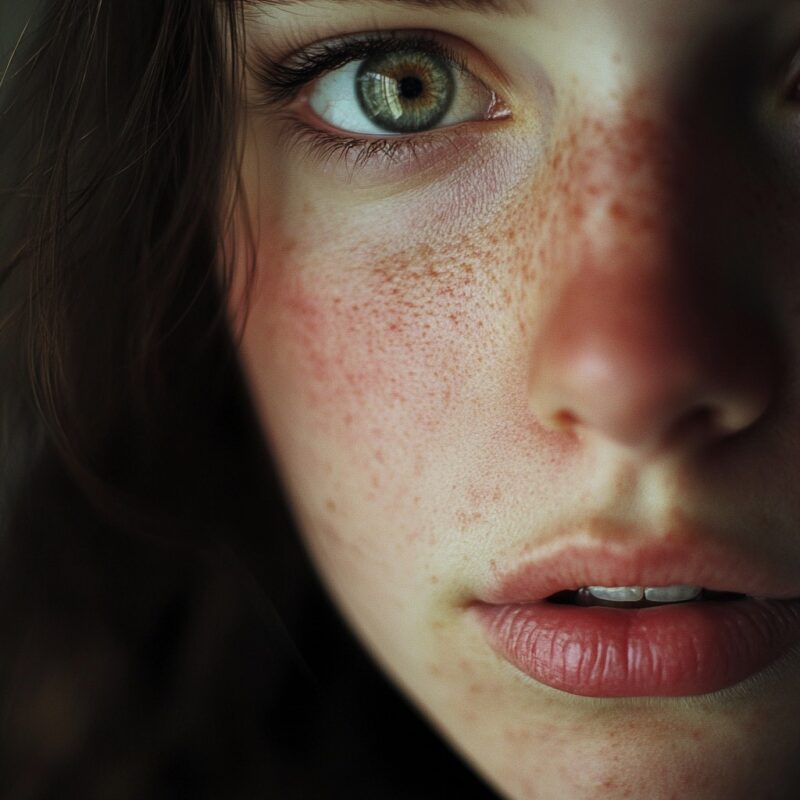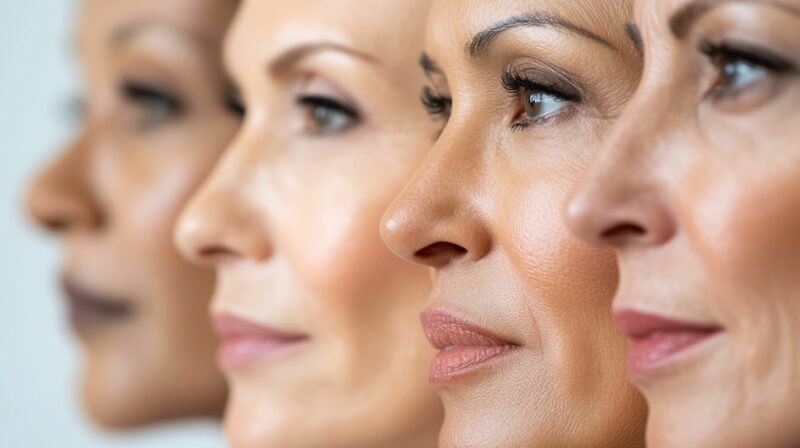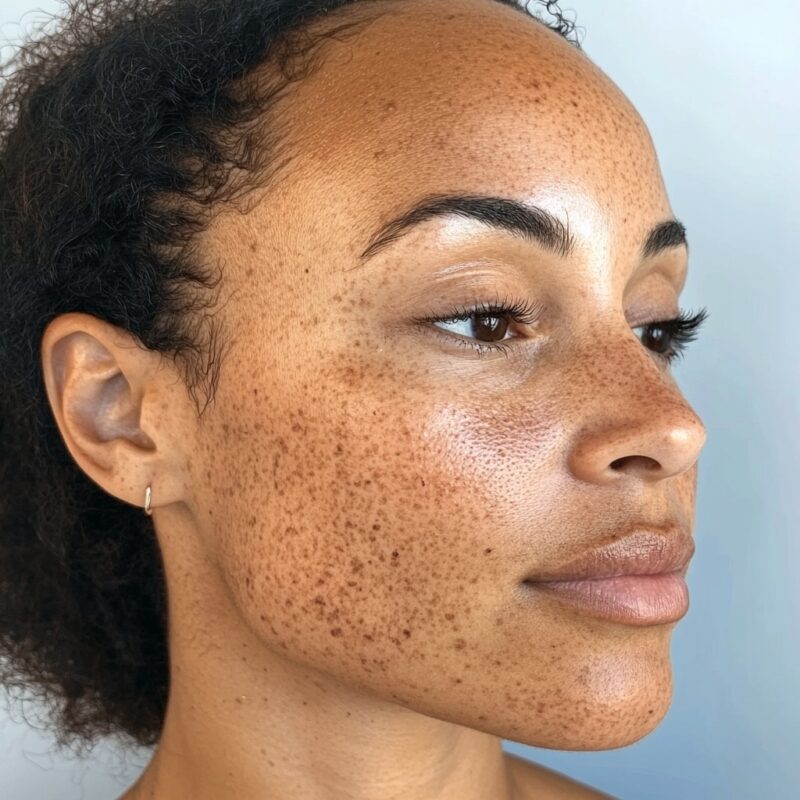Melanin is a pigment that provides color to the skin. It’s not always distributed evenly; when melanin collects in patches, it can create spots or darker areas known as hyperpigmentation.
Changes in skin tone can occur due to sun exposure, injury, medical conditions, or age.
There are treatments to restore the appearance of healthy skin, but first, we’ll provide a look at common types of hyperpigmentation.
Freckles

- Cause: Sun exposure
- Common areas: Face, neck, chest, and hands
- Appearance: Small brown spots
- Concern: Only worrisome if asymmetry, irregular borders, or changes in color develop
Freckles are small brown spots caused by sun exposure. They can appear at any age and are most commonly found on:
- Face
- Neck
- Chest
- Hands
While freckles are generally harmless, it is important to monitor them for any changes, such as irregular borders, asymmetry, or color changes, as these could be warning signs of skin conditions that may require medical attention.
Birthmarks

- Cause: Clusters of pigmented cells or malformed blood vessels
- Appearance: Present at birth in various colors
- Treatment: May disappear on their own, remain unchanged, or alter over time
As the name suggests, birthmarks are present at birth and can be the result of clusters of pigmented cells or malformed blood vessels.
They can come in various colors and may contain different types of tissue.
While some birthmarks may fade over time without treatment, others may stay the same or even change as one age.
Monitoring birthmarks for any unusual developments is important, as they may require medical evaluation if they change in appearance.
Melasma
- Cause: Hormonal changes (e.g., pregnancy, birth control pills)
- Appearance: Gray-brown patches
- Common areas: Cheeks, forehead, bridge of the nose, chin, upper lip
- Trigger: Sun exposure can worsen the condition
Melasma is a form of hyperpigmentation caused by hormonal changes, such as those experienced during pregnancy or as a side effect of birth control pills.
It typically appears as gray-brown patches on the face, including:
-
- Cheeks
- Forehead
- Bridge of the nose
- Chin
- Upper lip
Melasma can be aggravated by sun exposure, making it important to use sun protection to prevent the worsening of the condition.
Rosacea
- Cause: Not fully understood, but triggers include sun exposure, temperature changes, and increased blood flow
- Appearance: Patchy redness, sometimes with visible blood vessels
- Common areas: Cheeks, chin, nose, forehead
- Severity: Can lead to enlarged features in advanced stages
Rosacea is a condition characterized by patchy redness that often flares up for no apparent reason. These red areas can persist for weeks or months before disappearing.
Rosacea most commonly affects the cheeks, chin, nose, and forehead, and can be triggered by factors such as sunlight, extreme temperatures, and increased blood flow to the skin.
While early stages of rosacea may resemble blushing, more advanced stages can feature visible blood vessels and enlargement of the nose, chin, or oil glands.
Photoaging

- Other names: Age spots, liver spots, solar lentigines
- Cause: Years of prolonged sun exposure
- Appearance: Clusters of dark spots
- Common age: Late thirties to early forties
- Concern: Uneven skin tone due to excess melanin production
Photoaging, also known as age spots or solar lentigines, is a result of prolonged sun exposure over the years.
It often appears as clusters of dark spots on the skin, usually becoming noticeable in a person’s late thirties or early forties.
Sunlight stimulates excess melanin production, leading to uneven skin tone and visible discoloration.
While these spots are usually harmless, they can become a cosmetic concern for many.
Post-Inflammatory Hyperpigmentation (PIH)

Post-inflammatory hyperpigmentation (PIH) is a common condition often associated with acne.
After a pimple heals, the skin can produce excess pigment, leaving behind a dark spot that may linger for weeks or even months.
Causes of PIH
- Acne: One of the most common causes of PIH is acne. After inflammation from a breakout subsides, melanocytes (pigment-producing cells) go into overdrive, leading to dark spots.
- Skin Injuries: Any physical injury to the skin, such as scratches, cuts, or burns, can trigger PIH. As the skin heals, it may produce more melanin, resulting in darker patches.
- Insect Bites: Even something as small as an insect bite can lead to an overproduction of melanin at the injury site, causing PIH to develop.
The process behind PIH starts when melanocytes, or pigment cells, react to trauma or injury by producing excess melanin. This overproduction of pigment serves as a protective response to inflammation, but it can leave visible discoloration, especially in people with darker skin tones.
Conditions Associated with PIH
- Lupus: Chronic inflammatory conditions like lupus can lead to skin inflammation, which in turn may cause areas of hyperpigmentation to develop.
- Eczema: Inflammatory skin disorders such as eczema also increase the risk of PIH, as flare-ups often result in skin irritation, followed by darker patches once the inflammation resolves.
While PIH often fades over time, it can be persistent and frustrating for those affected.
How to Treat Hyperpigmentation
There are many types of treatments available for hyperpigmentation, depending on:
- Condition
- Severity
- Individual’s preferences
These treatments range from topical medications to chemical peels, and even surgical procedures.
Among modern options, radiofrequency (RF) laser therapy has gained popularity as a common and effective treatment. One of its advantages is the minimal recovery time it requires, making it a convenient choice for many.
Common Treatment Options
- Topical Medications: These often include prescription creams that contain ingredients like hydroquinone, retinoids, or corticosteroids. These help to lighten dark spots over time.
- Chemical Peels: These involve the application of a chemical solution to the skin, which exfoliates the outer layer, helping reduce pigmentation irregularities.
- Laser Therapy: Several types of laser treatments target pigmentation with great precision, offering long-lasting results.
Among these, radiofrequency laser therapy stands out due to its minimal downtime and effectiveness across various types of hyperpigmentation.
Laser Treatments and Their Benefits
- Fractionated RF Energy: This treatment stimulates collagen production while improving skin texture and reducing hyperpigmentation. It’s especially effective for skin discoloration and requires little recovery.
- Intense Pulsed Light (IPL): IPL therapy is highly beneficial for treating conditions like freckles, sun damage, rosacea, and various pigmented or vascular lesions. It works by emitting broad-spectrum light pulses that target pigmentation.
- Acoustic Lasers: These lasers are effective in treating melasma and brown spots. They break up pigmentation at deeper levels without damaging the surrounding skin.
- 1064 nm Lasers: For pigmentation that lies deep within the skin, 1064 nm lasers provide a non-invasive solution. This type of laser penetrates deep without affecting the skin surface, making it ideal for stubborn pigmentation issues.
The Bottom Line
Hyperpigmentation can appear in various forms, including melasma, sun spots, post-inflammatory hyperpigmentation (PIH), and freckles, each with its triggers and characteristics. For example, melasma is often influenced by hormonal changes, while sunspots are the result of prolonged UV exposure.
Post-inflammatory hyperpigmentation can occur after an injury or skin irritation, particularly in individuals with darker skin tones.
More persistent or deeper pigmentation issues may require more advanced treatments, such as chemical peels, laser therapies, or radiofrequency procedures. Each treatment type comes with its own benefits, and selecting the right one depends on your skin type, the nature of the pigmentation, and your personal preferences.

